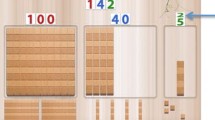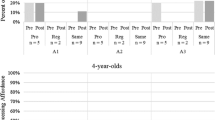Abstract
This paper focuses on understanding the role that affordances played in children’s learning performance and efficiency during clinical interviews of their interactions with mathematics apps on touch-screen devices. One hundred children, ages 3 to 8, each used six different virtual manipulative mathematics apps during 30–40-min interviews. The study used a convergent mixed methods design, in which quantitative and qualitative data were collected concurrently to answer the research questions (Creswell and Plano Clark 2011). Videos were used to capture each child’s interactions with the virtual manipulative mathematics apps, document learning performance and efficiency, and record children’s interactions with the affordances within the apps. Quantitized video data answered the research question on differences in children’s learning performance and efficiency between pre- and post-assessments. A Wilcoxon matched pairs signed-rank test was used to explore these data. Qualitative video data was used to identify affordance access by children when using each app, identifying 95 potential helping and hindering affordances among the 18 apps. The results showed that there were changes in children’s learning performance and efficiency when children accessed a helping or a hindering affordance. Helping affordances were more likely to be accessed by children who progressed between the pre- and post-assessments, and the same affordances had helping and hindering effects for different children. These results have important implications for the design of virtual manipulative mathematics learning apps.


Similar content being viewed by others
References
Aronin, S., & Floyd, K. K. (2013). Using an iPad in inclusive preschool classrooms to introduce STEM concepts. Teaching Exceptional Children, 45(4), 34–39.
Bartoschek, T., Schwering, A., Li, R., & Münzer, S. (2013). Ori-Gami–An App fostering spatial competency development and spatial learning of children. In D. Vandenbroucke, B. Bucher, & J. Crompvoets (Eds.), Proceedings of the 15th AGILE International Conference on Geographic Information Science. Leuven, Belgium: Springer.
Bertolo, D., Dinet, J., & Vivian, R. (2014). Reducing cognitive workload during 3D geometry problem solving with an app on iPad (Presented at the Science and Information Conference, pp. 896–900). London: IEEE. doi:10.1109/SAI.2014.6918292.
Bruner, J. S. (1964). The course of cognitive growth. American Psychologist, 19(1), 1–15.
Bullock, E. P., Moyer-Packenham, P. S., Shumway, J. F., Watts, C., & MacDonald, B. (2015). Effective teaching with technology: Managing affordances in iPad apps to promote young children’s learning. Unpublished manuscript.
Burlamaqui, L., & Dong, A. (2014). The use and misuse of the concept of affordance. In J. S. Gero (Ed.), Design Computing and Cognition DCC’14. Springer.
Byers, P., & Hadley, J. (2013). Traditional and novel modes of activity in touch screen math apps. In J. P. Hourcade, N. Sawhney, & E. Reardon (Eds.), Proceedings of the 12th International Conference on Interaction Design and Children. New York: ACM.
Cai, J., Lane, S., & Jakabcsin, M. S. (1996). The role of open-ended tasks and holistic scoring rubrics: Assessing students’ mathematical reasoning and communication. In P. C. Elliott (Ed.), Communication in mathematics, K-12 and beyond (pp. 137–145). Reston: The National Council of Teachers of Mathematics.
Carr, J. M. (2012). Does math achievement h’app’en when iPads and game-based learning are incorporated into fifth-grade mathematics instruction? Journal of Information Technology Education, 11, 269–286.
Chemero, A. (2003). An outline of a theory of affordances. Ecological Psychology, 15(2), 181–195. doi:10.1207/S15326969ECO1502_5.
Chen, L. L. (2011). Enhancing special needs student’s learning with iPad. In World Conference on E-Learning in Corporate, Government, Healthcare, and Higher Education (Vol. 2011, pp. 2324–2330). Retrieved from http://www.editlib.org/p/39076/.
Chen, L. L. (2012). Integrating iPad in a special education class: A case study. In World Conference on E-Learning in Corporate, Government, Healthcare, and Highez Education (Vol. 2012, pp. 530–534). Retrieved from http://www.editlib.org/p/41645/.
Cohen, B. H. (2014). Explaining psychological statistics (4th ed.). Hoboken: Wiley.
Corbin, J., & Strauss, A. (2014). Basics of qualitative research: Techniques and procedures for developing grounded theory. Thousand Oaks: Sage publications. Retrieved from https://books.google.com/books?hl=en&lr=&id=MaKWBQAAQBAJ&oi=fnd&pg=PP1&dq=Basics+of+qualitative+research:+Techniques+and+procedures+for+developing+grounded+theory&ots=QrDevRc5O0&sig=4EBsGKn1LSLNVTMdws57MfHAOuo.
Creswell, J. W., & Plano Clark, V. L. (2011). Designing and conducting mixed methods research (2nd ed.). Thousand Oaks: Sage Publications, Inc.
DeCuir-Gunby, J. T., Marshall, P. L., & McCulloch, A. W. (2012). Using mixed methods to analyze video data: A mathematics teacher professional development example. Journal of Mixed Methods Research, 6(3), 199–216.
Gaver, W. W. (1991). Technology affordances. In Proceedings of the SIGCHI conference on human factors in computing systems (pp. 79–84). New York: ACM. doi:10.1145/108844.108856.
Gibson, J. J. (1986). The ecological approach to visual perception. Hillsdale: Lawrence Erlbaum Associates.
Gravetter, F. J., & Wallnau, L. B. (2013). Statistics for the behavioral sciences (9th ed.). Belmont: Wadsworth.
Greene, J. C., Caracelli, V. J., & Graham, W. F. (1989). Toward a conceptual framework for mixed-method evaluation design. Educational Evaluation and Policy Analysis, 11, 255–274.
Greeno, J. G. (1994). Gibson’s affordances. Psychological Review, 101(2), 336–342. doi:10.1037/0033-295X.101.2.336.
Gröger, C., Silcher, S., Westkämper, E., & Mitschang, B. (2013). Leveraging apps in manufacturing. A framework for app technology in the enterprise. Procedia CIRP, 7, 664–669. doi:10.1016/j.procir.2013.06.050.
Haydon, T., Hawkins, R., Denune, H., Kimener, L., McCoy, D., & Basham, J. (2012). A comparison of iPads and worksheets on math skills of high school students with emotional disturbance. Behavioral Disorders, 37(4), 232–243.
Kilic, A. (2013). An investigation of the use of the iPad and textbooks on the achievement of students with special needs in algebra (Master’s thesis). New Jersey: Rowan University.
Kortenkamp, U., & Ladel, S. (2013). Designing a technology based learning environment for place value using artifact-centric activity theory. In A. M. Lindmeier & A. Heinze (Eds.), Proceedings of the 37th conference of the International Group for the Psychology of Mathematics Education. Mathematics learning across the life span (Vol. 1, pp. 188–192).
McGrenere, J., & Ho, W. (2000). Affordances: Clarifying and evolving a concept. In Graphics interface (Vol. 2000, pp. 179–186). Montreal: Lawrence Erlbaum Associates.
Moyer, P. S., Bolyard, J. J., & Spikell, M. A. (2002). What are virtual manipulatives? Teaching Children Mathematics, 8(6), 372–377.
Moyer-Packenham, P. S., & Westenskow, A. (2013). Effects of virtual manipulatives on student achievement and mathematics learning. International Journal of Virtual and Personal Learning Environments, 4(3), 35–50.
Moyer-Packenham, P. S., Anderson, K. L., Shumway, J. F., Tucker, S., Westenskow, A., Boyer-Thurgood, J., Bullock, E., Mahamane, S., Baker, J., Gulkilik, H., Maahs-Fladung, C., Symanzik, J., Jordan, K., & The Virtual Manipulatives Research Group at Utah State University. (2014a). Developing research tools for young children’s interactions with mathematics apps on the iPad (pp. 1685–1694). Honolulu, Hawaii: Proceedings of the 12th Annual Hawaii International Conference on Education (HICE). ISSN# 1541–5880.
Moyer-Packenham, P. S., Westenskow, A., Shumway, J. F., Bullock, E., Tucker, S. I., Anderson- Pence, K. L., Boyer-Thurgood, J., Maahs-Fladung, C., Symanzik, J., Mahamane, S., MacDonald, B., Jordan, K., & The Virtual Manipulatives Research Group at Utah State University. (2014b). The effects of different virtual manipulatives for second graders’ mathematics learning and efficiency in the touch-screen environment (Paper presentation). Herceg Novi, Montenegro: 12th International Conference of the Mathematics Education into the 21st Century Project.
Moyer-Packenham, P. S., Shumway, J. F., Bullock, E., Tucker, S. I., Anderson-Pence, K. L., Westenskow, A., Boyer-Thurgood, J., Maahs-Fladung, C., Symanzik, J., Mahamane, S., MacDonald, B., & Jordan, K. (2015). Young children’s learning performance and efficiency when using virtual manipulative mathematics iPad apps. Journal of Computers in Mathematics and Science Teaching, 34(1), 41–69.
Paek, S. (2012). The impact of multimodal virtual manipulatives on young children’s mathematics learning (Doctoral dissertation). Retrieved from ProQuest Dissertations & Theses Full Text. (UMI No. 3554708).
Paek, S., Hoffman, D., Saravanos, A., Black, J., & Kinzer, C. (2011). The role of modality in virtual manipulative design. In D. Tan, B. Begole, & W. A. Kellogg (Eds.), CHI conference on human factors in computing systems (pp. 1747–1752). New York, NY: ACM. doi:10.1145/1979742.1979839.
Paek, S., Hoffman, D. L., & Black, J. B. (2013). Multi-modal interaction with virtual manipulatives: Supporting young children’s math learning. In N. Rummel, M. Kapur, M. Nathan, & S. Puntambekar (Eds.), Proceedings, 10th International Conference on Computer-Supported Collaborative Learning. (Vol. 2, pp. 117–120). Madison, WI.
Patton, M. Q. (1990). Qualitative evaluation and research methods (2nd ed.). Newbury Park: Sage Publications, Inc.
Piaget, J. (1970). The child’s conception of movement and speed. New York: Basic Books (Original work published 1946).
Reid, D., & Ostashewski, N. (2011). iPads in the classroom–new technologies, old issues: Are they worth the effort? In World Conference on Educational Multimedia, Hypermedia and Telecommunications (Vol. 2011, pp. 1689–1694). Retrieved from http://www.editlib.org/p/38089/.
Riconscente, M. M. (2012). Mobile learning game improves 5th graders’ fractions knowledge and attitudes (p. 46). Los Angeles: GameDesk Institute. Retrieved from http://www.gamedesk.org/reports/MM_FINAL_REPORT.pdf .
Riconscente, M. M. (2013). Results from a controlled study of the iPad fractions game motion math. Games and Culture, 8(4), 186–214.
Roschelle, J. (2000). Choosing and using video equipment for data collection. In A. E. Kelly & R. Lesh (Eds.), Handbook of research design in mathematics and science education (pp. 709–729). Mahwah: Lawrence Erlbaum Associates, Inc.
Schubert, C. (2009). Video analysis of practice and the practice of video analysis. In H. Knoblauch, B. Schnettler, J. Raab, & H. G. Soeffner (Eds.), Video analysis methodology and methods: Qualitative audiovisual data analysis and sociology (pp. 115–126). New York: Peter Lang.
Shuler, C. (2009). Pockets of potential: Using mobile technologies to promote children’s learning. New York: The Joan Ganz Cooney Center at Sesame Workshop. Retrieved from http://hal.archives-ouvertes.fr/hal-00696254 .
Spencer, P. (2013). iPads: Improving numeracy learning in the early years. In V. Steinle, L. Ball, & C. Bardini (Eds.), Mathematics education: Yesterday, today, and tomorrow: Proceedings of the 36th annual conference of the Mathematics Education Research Group of Australasia (pp. 610–617). Melbourne: MERGA.
Tashakkori, A., & Teddlie, C. (2008). Introduction to mixed method and mixed model studies in the social and behavioral sciences. The Mixed Methods Reader, 7–26.
Teddlie, C., & Tasshakori, A. (2006). A general typology of research designs featuring mixed methods. Research in the Schools, 13(1), 12–28.
Tucker, S. I., & Moyer-Packenham, P. S. (2014). Virtual manipulatives’ affordances influence student learning. In S. Oesterle, C. Nicol, P. Liljedahl, & D. Allan (Eds.), Proceedings of the joint meeting of PME 38 and PME-NA 36 (Vol. 6, p. 251). Vancouver: PME.
Tucker, S. I., Moyer-Packenham, P. S., Shumway, J. F., & Jordan, K. (2014). Zooming in on students’ thinking: How a number line app revealed, concealed, and developed students’ number understanding. Unpublished manuscript.
Acknowledgments
Financial support for the work reported in this paper was provided for a project titled: Captivated! Young Children’s Learning Interactions with iPad Mathematics Apps, funded by the Vice President for Research Office category of Research Catalyst Funding at Utah State University, 2605 Old Main Hill, Logan, UT 84322, USA.
Author information
Authors and Affiliations
Corresponding author
Appendixes
Appendixes
Appendix A
Mathematics apps selected for the pre- and post-assessments and learning activities

Appendix B
Sample of coding protocol for preschool

Appendix C
Rights and permissions
About this article
Cite this article
Moyer-Packenham, P.S., Bullock, E.K., Shumway, J.F. et al. The role of affordances in children’s learning performance and efficiency when using virtual manipulative mathematics touch-screen apps. Math Ed Res J 28, 79–105 (2016). https://doi.org/10.1007/s13394-015-0161-z
Received:
Revised:
Accepted:
Published:
Issue Date:
DOI: https://doi.org/10.1007/s13394-015-0161-z




